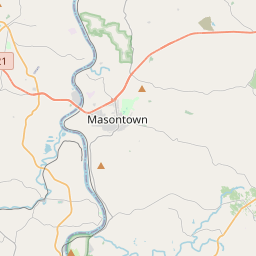First Roads to the West
Historical marker location:
Farmington, Pennsylvania
( Marker can be reached from National Pike (U.S. 40) 1.2 miles east of Fayette Springs Road.)







© OpenStreetMap contributors
Fort Necessity National Battlefield. National Park Service, U.S. Department of the Interior
Loading...
Searching for other points of interest within 3 miles of this location.Pennsylvania was once home to a giant freshwater mussel called the Pennsylvania pigtoe, which is now considered endangered.
About Fayette County
Fayette County Timeline
Fayette County, Pennsylvania has a rich history that dates back to precolonial times. The region was originally inhabited by various Native American tribes, including the Delaware, Shawnee, and Iroquois, who relied on the fertile lands and abundant resources of the area for their livelihoods. European settlement began in the 18th century, with English and Scottish immigrants migrating to the region.
During the American Revolution, Fayette County played a significant role as a strategic location. The area was a contested region, witnessing various clashes between American and British forces. Notably, the Battle of Brandywine in September 1777, one of the largest battles of the war, took place partly in what is now Fayette County.
The early 19th century brought industrialization to Fayette County, driven by its vast coal and coke deposits. The county became a major producer of coal and coke, attracting numerous immigrants seeking employment in the booming mining and steel industries. Towns like Uniontown and Connellsville grew rapidly, becoming central hubs for coal mining and related industries.
In the late 19th and 20th centuries, Fayette County experienced both economic booms and challenging times. The decline of the coal industry in the mid-20th century led to a period of economic decline, with many mines closing and communities facing significant challenges. However, recent decades have seen efforts to diversify the economy and revitalize the region through the development of tourism, recreation, and small businesses.
Today, Fayette County continues to embrace its historical roots while adapting to changing times. Visitors can explore the rich history of the area through numerous historical landmarks, including Fort Necessity, Braddock's Grave, and various museums. Additionally, the county is known for its abundant outdoor recreational opportunities, including hiking, fishing, and boating along the Youghiogheny River and Laurel Highlands.
During the American Revolution, Fayette County played a significant role as a strategic location. The area was a contested region, witnessing various clashes between American and British forces. Notably, the Battle of Brandywine in September 1777, one of the largest battles of the war, took place partly in what is now Fayette County.
The early 19th century brought industrialization to Fayette County, driven by its vast coal and coke deposits. The county became a major producer of coal and coke, attracting numerous immigrants seeking employment in the booming mining and steel industries. Towns like Uniontown and Connellsville grew rapidly, becoming central hubs for coal mining and related industries.
In the late 19th and 20th centuries, Fayette County experienced both economic booms and challenging times. The decline of the coal industry in the mid-20th century led to a period of economic decline, with many mines closing and communities facing significant challenges. However, recent decades have seen efforts to diversify the economy and revitalize the region through the development of tourism, recreation, and small businesses.
Today, Fayette County continues to embrace its historical roots while adapting to changing times. Visitors can explore the rich history of the area through numerous historical landmarks, including Fort Necessity, Braddock's Grave, and various museums. Additionally, the county is known for its abundant outdoor recreational opportunities, including hiking, fishing, and boating along the Youghiogheny River and Laurel Highlands.
Fayette County Timeline
This timeline provides a glimpse into the major events and milestones that have shaped the history of Fayette County, Pennsylvania.
- 1754: The area that is now Fayette County is explored by Christopher Gist, an agent for the Ohio Company
- 1755: Fort Necessity is built by George Washington during the French and Indian War
- 1783: Fayette County is officially created from part of Westmoreland County
- 1793: The town of Uniontown, the county seat, is founded
- 1831: The National Road is completed, passing through Fayette County and contributing to its economic growth
- 1861-1865: Fayette County sends soldiers to fight in the American Civil War
- 1944-1945: The Belle Vernon Area School District is formed through the consolidation of several smaller school districts
- 1962: The construction of the Youghiogheny Dam and Reservoir is completed, providing flood control and recreational opportunities
- 1979: The "Whiskey Rebellion" monument is dedicated in commemoration of the 1794 tax protest in Fayette County
- 1992: The Great Allegheny Passage, a hiking and biking trail, opens in Fayette County